If you have ever heard of e-commerce, Shopify won't be a strange name. It is a huge pillar and platform behind many e-markets.
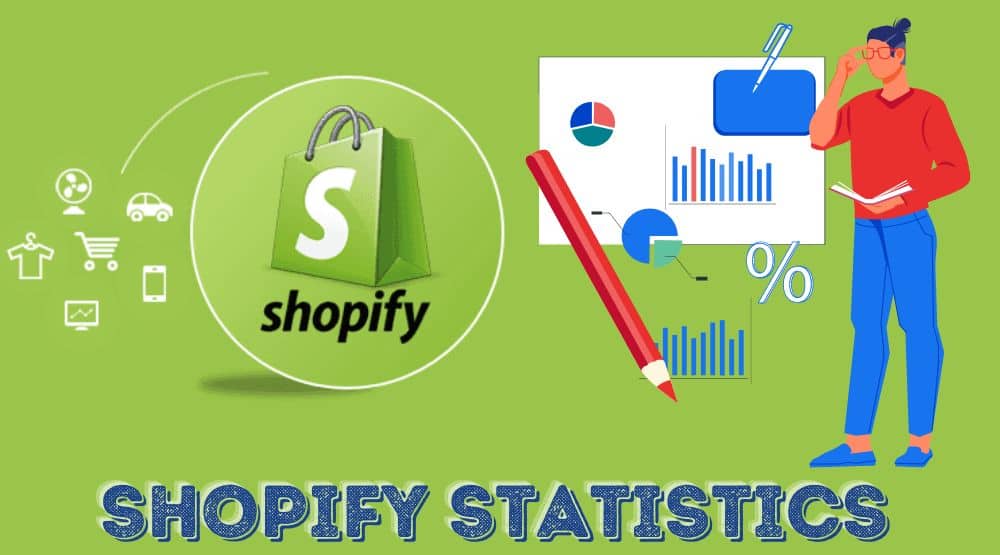
This platform which has grown to have thousands of employees and stores in over 170 countries, was founded about 16 years ago. Founded in Ottawa, Ontario in, Canada, Shopify was born from an unsatisfactory experience of 3 young men in e-commerce.
Today, this e-commerce platform serves a large population of the US and has more than 5000 businesses on it. In addition to this, Shopify has many of the richest companies in the world as its biggest customers.
Furthermore, the global contribution of Shopify is more than the annual budget of many African countries. It has a large share of more than 20%. Globally, there are many competitors who contend with Shopify. This competition takes many angles. They compete in revenue, market worth, and the number of domains hosted on these platforms.
Shopify has many popular languages embedded in its apps and stores. It is, therefore, a good option for many e-market business owners who speak languages other than English.
Are you thinking of having a store on Shopify? Now come on, let's see the statistics of Shopify.
Key Shopify Statistics You Need to Know in 2023
- There are over 1.75 million merchants on Shopify.
- Shopify's net worth is $4.82 billion.
- There are Shopify stores in 175 countries of the world.
- Shopify has 10000 employees across the globe
- There are over 3200 apps on the Shopify store.
30+ Shopify Statistics, Facts & Trends
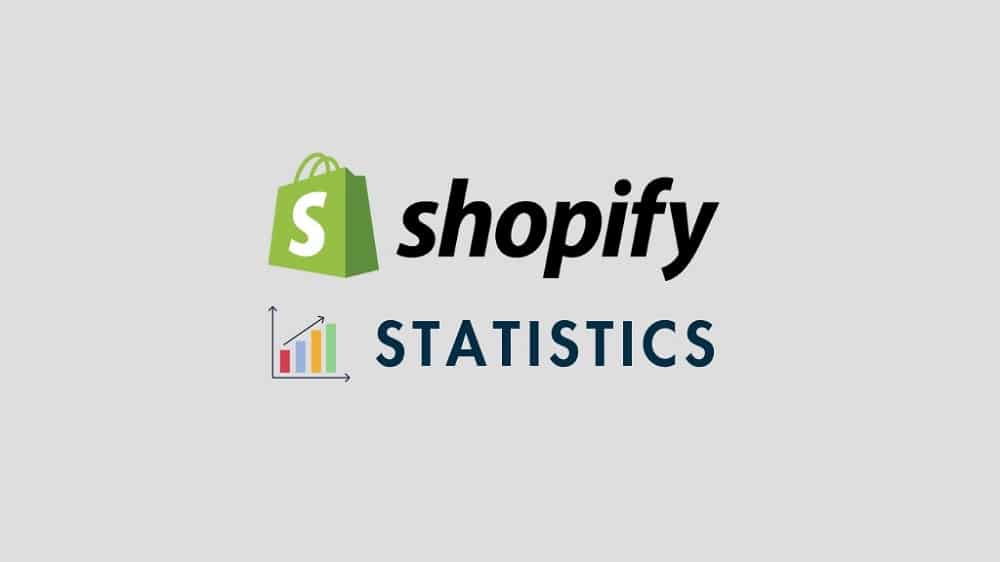
How Many People Use Shopify Globally?
The outcome of lockdown during the Pandemic has really influenced the rate of online shopping and e-businesses. Thus, the number of people whose businesses are hosted on Shopify has significantly increased during and after the lockdown.
Also, the number of people visiting stores on Shopify has multiplied rapidly, drubbing and after the lockdown. Although Shopify was in existence before lockdown for more than a decade, the pandemic year marked a significant growth in its popularity.
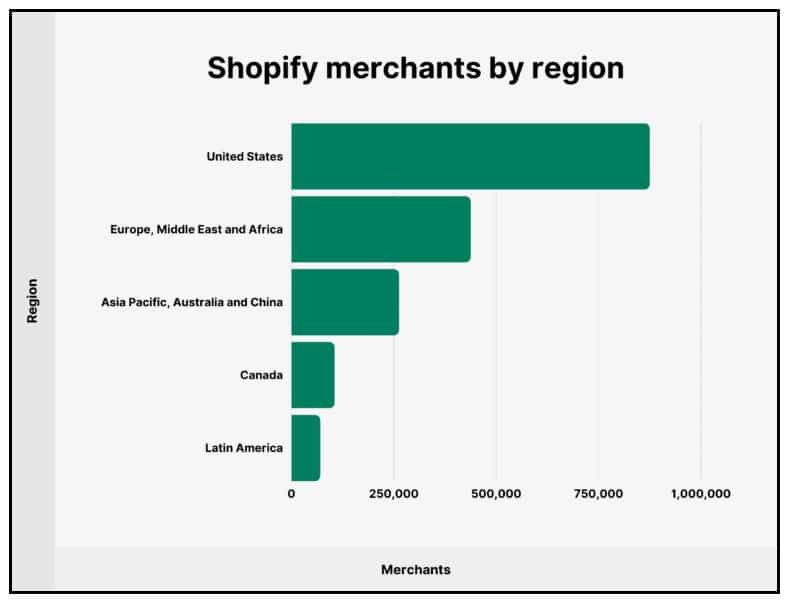
There are 1.75 million merchants whose businesses are hosted on Shopify in 2021. In addition, these merchants had a total of 457 million buyers in 2020. However, the number has increased to approximately 480 million in 2021. This is a reflection of the increased popularity it gained during the 2020 lockdown.
[Source: BackLinko]
What Is The Demography Of Shopify Merchants?
Demography, the sex and age distribution of a set of people tells a lot about the expected pattern of behaviors and traits of such people. In a business organization like Shopify, it tells the rate of inclusion and gender diversity. Data at hand shows that Shopify has slightly above 52% of female merchants and approximately 47% male merchants. In addition, the age distribution of these merchants is further revealed by this data.
Hence, there are 7.3% of merchants in the age bracket of 18 – 24 years, and the most significant percentage of merchants, 37.5%, is within the 25 – 34 years age bracket. Again, 30% of the merchants belong to 35 – 44 years of age, and lastly, 24.9% are 45 years and above.
Thus, it is true to say that the highest number of merchants on Shopify are in their mid-20s to mid-30s. Furthermore, most of these age brackets are males.
[Source: Truelist]
What Is Shopify's Net Worth?
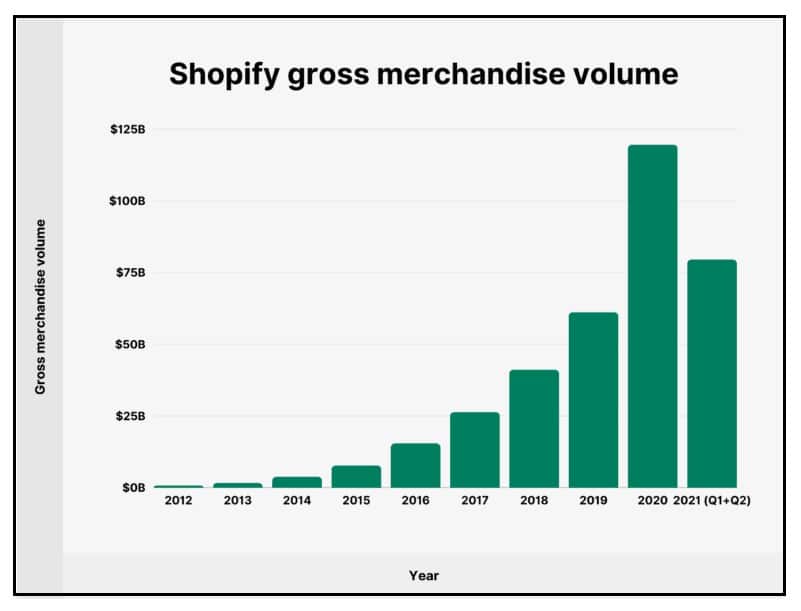
Shopify, as an E-commerce platform, transcended to stardom among its counterpart in 2020. Although it has maintained an appreciable increasing amount of growth in assets and net worth before this time, the growth has been remarkable since 2020.
Therefore, Shopify's significant growth has always been reflected in its net worth and the increasing number of merchants. This E-commerce platform has not reached two decades, yet it has come to outshine many of its types.
As of August 2022, the net worth of Shopify was declared to be $40.82 billion. The net worth was slightly above $20 billion a year before the pandemic. Therefore evaluators claimed it had doubled its Net worth by the first two quarters of 2022.
[Source: Macrotrends]
What Is Shopify's Annual Revenue?
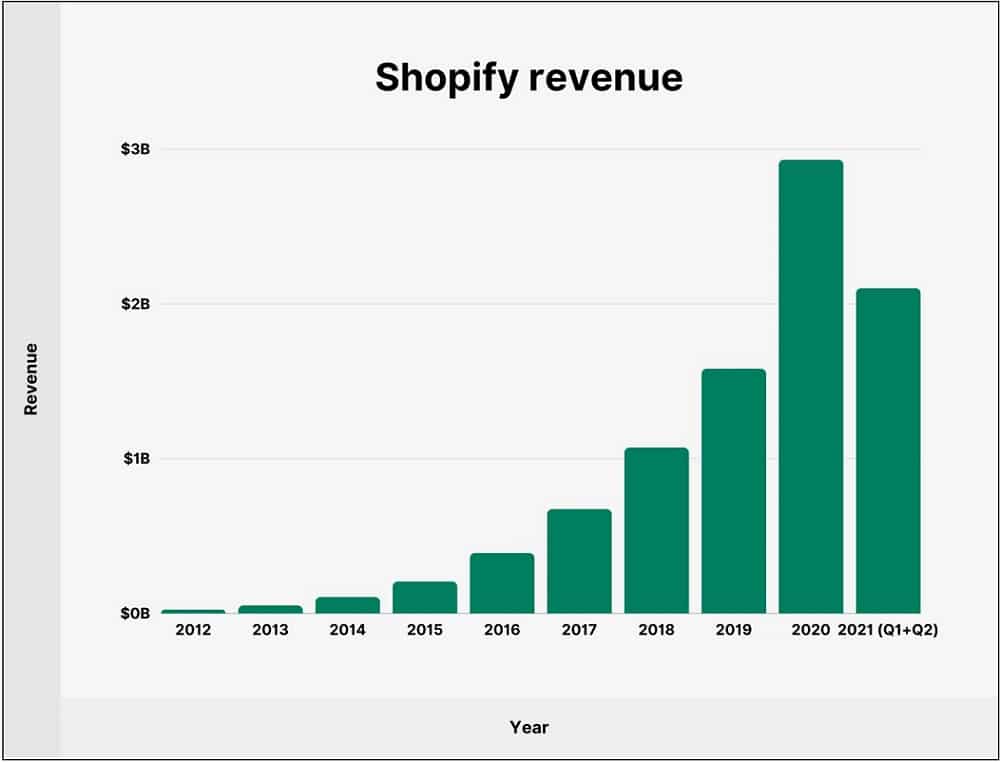
The total amount of income made by a firm from sales of products and services account for its revenue. On a yearly basis, revenue is liable to check depending on the economic trend and rates of sales. At Shopify, there has been a consistent increase in revenue each year. However, the most significant increase was recorded in the year 2020.
This growth in revenue was linked to the strict restrictions against physical contact during the lockdown. Thus people resolved to E-marketing. In 2019, the revenue was $1.57 billion. An increase of 47.05% was recorded when compared to 2018 revenue. In 2020, a huge revenue of $2.92 billion was recorded at Shopify. This was an 85.63% increase in comparison with 2019. As of July 2022, Shopify's total revenue was $1.29 billion.
[Source: Macrotend]
How Many Countries Are There Shopify?

Many times, the growth of a company is measured with monetary and asset parameters. Thus the revenue and net worth of the firm tell how big the company is. However, the growth of a firm is also measured by the rate it expands its service coverage. Thus it reflects the wide acceptability and popularity of the firm.
Shopify, which was founded by a few individuals in Canada as a result of their displeasure with online commerce, has grown to become a worldwide platform.
Today, there are more than 500,000 businesses on Shopify. These businesses are spread across 175 countries of the world. Thus, it has grown its horizon from Ottawa in Canada to many countries on different continents and countries of the world.
[Source: Shopify]
Number Of Websites That Use Shopify
The major rationale behind the creation of Shopify is to create a platform upon which e-business will be hosted. Over the years, the number of businesses that are based on this platform has increased rapidly, most importantly during and after the lockdown. Today, several websites make use of the Shopify platform to trade their product and render their services.
Data collected in 2021 revealed that there are 2,297 million active websites that are using the Shopify platform. These websites are being used by a huge number of over 1.75 million merchants to sell different products and services. Then you can wonder less how it manages to amass more than 400 million buyers from these merchants. This is a good indication of how big of a platform Shopify is.
[Source: Popupsmart]
How Many Staff Does Shopify Have?

The increasing global population is enough reason for the expansion of companies and businesses around the world. Thus, it is understandable that in an attempt to meet the need of consumers, companies would need more workforce. Shopify has also grown in terms of the number of employees over the years.
In 2018 and 2019, the total number of employees at Shopify was 4000 and 500, respectively. In the year 2020, during the lockdown, the number of employees grew to 7000. This was an addition of 40% workforce when compared to 2019 before the pandemic.
Continuously, 2021 also marked an increasing number of employees at Shopify. Thus, its total workforce stood at 10000. This was approximately a 42% increase added to the 2020 number of employees.
[Source: Macrotrend]
What Rank Is Shopify On The World List Of E-commerce Platforms?
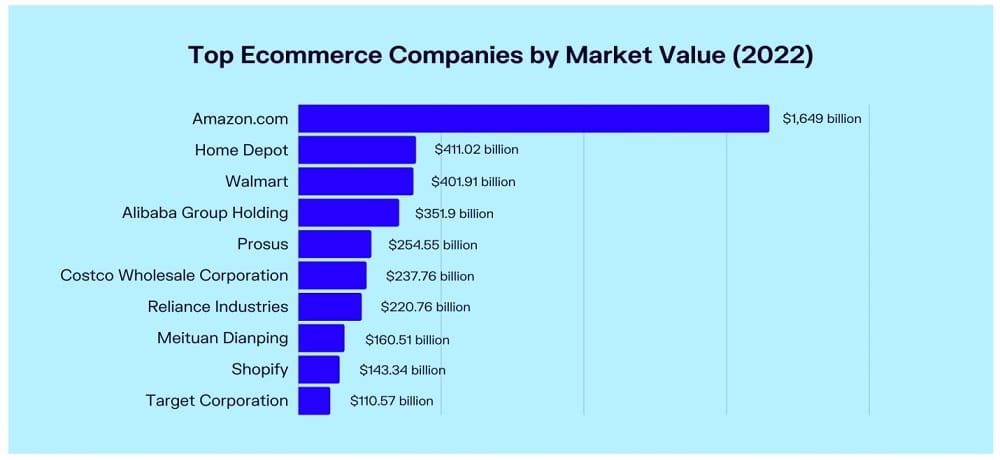
By far, Shopify is ranked the number one e-commerce platform across the globe. Thus it is arguable that Shopify is the best software-based platform for e-commerce. In fact, Shopify has a higher number of great and unique businesses that are hosted on its planet than its counterparts.
The 2022 ranking of e-commerce platforms ranked Shopify as number one. Not only that, it was crowned as the best for easy and all-inclusive e-commerce store building. The ranking listed Wix as the best for smaller stores. This ranking also named Squarespace as the best e-commerce platform for money value.
[Source; Shopify, Websitebuilder]
How Many E-commerce Platforms Compete With Shopify?
Competition among companies is a win-win for consumers as it increases quality and customer care services. This has become a bit stiffer with the level ground for competition that is presented by the internet. Hence, internet-based businesses face more competition and thereby have reason to step up their game.
As such, Shopify, despite remaining at the top of the rank among e-commerce platforms, faces strong competition. Therefore, there are major 6 e-commerce platforms. Although the strength and angle of competition differ per platform, they all contend with Shopify.
These are Wix, Squarespace, Square Online, BigCommerce, Volusion, and WooCommerce. These names are arranged based on their strength of competition with Shopify.
[Source: Websitebuilderexpert]
What Is Shopify’s Growth rate?

The growth rate of a company is measured through its revenue but in terms of percentage, not in monetary value. In other words, the sales rate is translated through the total income of a company through scale. Therefore, the sales rate of a year, when compared to the previous year, tells the growth rate is either negative or positive.
Shopify's growth rate in 2019, when compared to 2020 (lockdown period), experienced a huge rate of 86.63%. Although the growth rate in the following year, 2021, was not as high as in 2020, it maintained an increasing rate of 57.43%. So far this year, Shopify has recorded a 15.69% in its growth rate. It is expected that by the end of the year it will grow higher.
[Source; Macrotrend]
How many people founded Shopify?
Many of the great businesses and companies of the world were founded by a single person that later grew to be accepted by many other individuals. As such, you will trace the founder back to one person. However, few other great companies have more than one founders who conceived the entrepreneurial idea or business concept.
Thus, they have more than one founder. Shopify belongs to this group. This 16-year-old e-commerce platform has 3 founders. Tobis Lütke, Daniel Weinnand, and Scott Lake are the founders of this platform.
They collectively launched the Shopify platform in 2006 in Ottawa, Ontario, Canada. You can then say that Shopify is not a sole proprietor business organization.
[Source: Wikipedia]
Who Are The Shareholders In Shopify And What Is Their Respective Percentage?
It is not uncommon for multinational companies and corporations to trade stakes with institutions or individuals. This is also ten with Shopify. Stakeholders or Shareholders in Shopify are of two kinds. There are institutions that have shares in Shopify.
Although the number of shareholders increases year-in-year-out because Shopify still sells shares, there are top shareholders. The top institutional shareholder with the highest percentage of the stake at Shopify is Morgan Stanley, with 6.18%.
On the other hand, Harbor Capital Appreciation Fund has the largest share of 9.04% among mutual fund holders at Shopify. The table below further reveals the top 8 shareholders at Shopify with respect to their percentages of shares.
| Shareholders | Percentages of Share |
| Harbor Capital Appreciation Fund | 9.04% |
| Morgan Stanley | 6.18% |
| Baillie Gifford and Company | 4.83% |
| Capital Research Global Investors | 3.20% |
| Vanguard Group, Inc. (The) | 3.16% |
| Price (T.Rowe) Associates LLC | 2.63% |
| Europacific Growth Fund | 2.45% |
| Jennison Associates LLC | 2.43% |
[Source: Yahoo!Finance]
How Many Companies Has Shopify Acquired?

By virtue of mergers and firm acquisitions, multinational companies and businesses expand their structure and horizon. Shopify also has an interest in acquiring other companies. Over the years, Shopify has acquired 11 Companies. Among these companies, 5 major ones were acquired in the last 5 years.
This actively demonstrates the rapid expansion of Shopify in the last couple of years. Shopify announced its largest acquisition of the company in 2022, when it acquired Deliverr for $2.1 billion.
Among these companies, 4 were acquired from different US states and 3 other countries. Given its main jurisdiction, Shopify’s most targeted sector/company is software which accounts for 46%. In addition, it has 37% of its interest in purchasing internet software and services.
[Source: Mergr]
What is Shopify's Gross Margin?
The gross margin of a company tells the difference between the company’s revenue and the cost of goods sold or services rendered and divided by the revenue. In other words, it reveals what amount of profit the company made in total before deduction of any form. This amount is later related in percentage to the amount left after other costs are deducted.
In the last quarter of 2019, Shopify’s gross margin was 54.88%. By the end of 2020, the pandemic year, Shopify had a gross margin of 52.61%. In addition, the end of the year 2021 recorded a gross margin of 53.82%.
By ending of June 2022, the gross margin so far was 51.89% for this year. Thus the gross margin by the end of this year is projected to be higher.
[Source: Macrotrend]
How Many Orders have been processed on Shopify?
There has been an increasing number of orders processed via Shopify since it began operation in 2006. Notably, the rate of use has increased rapidly since the early period of 2020. To date, this increasing trend has maintained its momentum.
Data reported in October 2019 revealed that sales worth $135 billion and more had been processed on Shopify. It was in this same year that Shopify recorded 218 million traffic buyers on its platform.
In 2020, the total orders processed on Shopify passed $150 billion worth of sales. The aftermath of the lockdown in 2021 also recorded sales of close to $180 billion worth in total.
[Source: Shopifyandyou]
What Is The Average Salary Paid To A Shopify Employee?
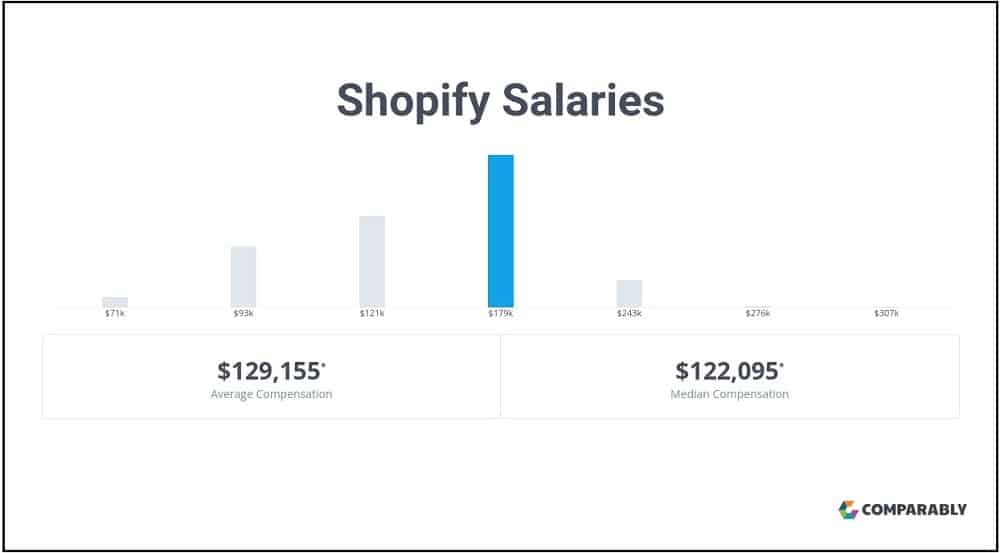
The payment scale at Shopify is gauged based on the number of hours the employee worked. Thus, in addition to the level of education, the level of training, and also the position held by an employee, a number of productive hours are important.
Generally, the average salary at Shopify is $128,745 per annum. This is on a scale of $61.90 per hour. The entry-level salary at Shopify is gauged at $90,000 yearly. The experienced level has a salary scale of up $182,000 per annum.
There exist a significant difference between the bottom 10% of Shopify earners and the top 10% of earners. It is normal at Shopify that an employee in business and development jobs earns the highest salaries. The location also influences the pay of an employee.
Thus, employees working in San Francisco, Seattle, and Brookline tend to earn more.
[Source: Zippia]
Numbers of Shopify Stores
The number of Shopify stores has rapidly increased in different countries of the World. In many 2022, Shopify has recorded 5.6 million online Stores. By statistics, about 70% of these domains are enrolled on Shopify in the US, UK, and Australia, respectively.
In 2014, Shopify launched its personalized application framework for growing businesses. It is called ‘Shopify plus’. Due to its cost-effectiveness and potency of service, Shopify plus has grown to have 25,700 Shopify plus stores across 175 countries. These stores serve millions of enterprises.
As expected, the US has the most significant percentage of these stores, 60%. Next in line is the UK, having 8%, Australia has 5%, and Canada has 5%. It is therefore understandable when data shows that the US has 50% of Shopify merchants.
[Source: Demansage]
How much Debt has Shopify Incurred?

It is no longer news that companies incur debts in the course of running the business smoothly. Thus, this debt accumulates over the years and becomes a long-term debt. However, this debt is been serviced annually, thereby reducing the debt. Shopify, in this case, is not excluded.
Therefore, it has a long-term debt of $0.912 billion as of the end of June 2022. This accounts for a 14.03% decline from year-over-year.
In 2021, the long-term debt at Shopify stood at $1.158 billion. This was a huge increase of 28.23% from its debt of $0.903 billion in 2020. It is estimated that there will be a significant decline in the amount of Shopify’s debt by the end of 2022.
[Source: Macrotrend]
How Much Is Required To Run A Shopify Store?
Opening a store for your business is as simple as opening a Whatsapp account. Another juicy part of it is that Shopify offers two weeks free trial. As such, you can test the effectiveness and credibility of the platform before a monetary commitment. There are three major plans on Shopify for e-business stores.
These are Basic, Shopify, and Advanced. Although prices vary, they are affordable. The Basic plan is charged at $29 monthly. It is, therefore, the most popular and most used. The Shopify plan goes for $79 per month with more features than the former.
And lastly, Advanced Shopify, which is the best with custom reporting and has the lowest transaction fee is $299 per month. As each plan has a different number of staff, a number of inventory locations, and professionalism of business report.
[Source: Shopify]
What Is The Global Contribution Of Shopify To The Economy?
The global economy of the world is driven by Power Resources and the Trading of technologies and other products. Without a doubt, e-commerce has eased the transaction of many trades. It has helped in overcoming the friction of distance. Thus, it is an integral part of the Global economy.
Shopify, as one of the giant platforms of e-commerce, contributes immensely to the Global economy. Data has shown that $319 billion generated on the Shopify platform contributes greatly to global economic activities.
Hence, the democratizing of commerce by Shopify has made it easy for all sizes of businesses to grow. It is, therefore, a huge contribution that comes from Shopify to the movement of the global economy.
[Source: Shopify]
What Are The Biggest Industries On Shopify Plus?
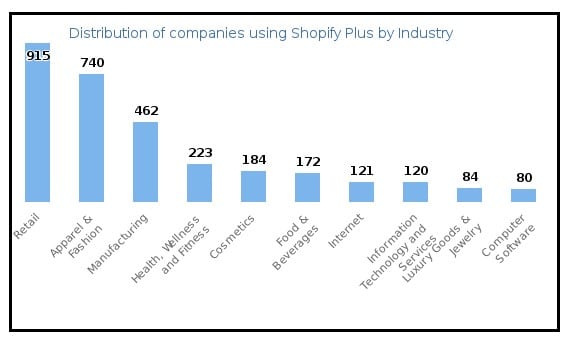
There are several types of business industries that are trading on Shopify Plus. It does not matter the business type, one certain fact is there is higher patronage recorded on some businesses than others. This reflects the type of products people order most on these Shopify Merchants and Industries. There are three major industries making the most sales on Shopify plus. These are; Retail, Fashion, and Computer Software, respectively.
These three giant industries collectively account for 34% of sales on Shopify Plus. These three are followed by wholesale, Consumer goods, Health and Wellness, IT, and the Internet. This simply demonstrates that these industries do not only make the highest sales but also have the highest number of stores respectively.
[Source: Enlyft]
What Source Accounts For The Highest Percentage Of Traffic On Shopify?
It is expected that the traffic on the platforms like Shopify would be of high volume. It is quite understandable. However, the sources of the traffic might differ from one device to the other. Over the years, mobile has always accounted for a high percentage of traffic.
In 2014, traffic from mobile accounted for 50% of Shopify Stores. With the passage of years, the amount of traffic from mobile has increased with increasing technology of mobiles.
Thus, mobile now accounts for 79% of Shopify traffic. This reflects the ease and smooth usage of users on Shopify Stores. Especially on Black Fridays and Cyber Monday, many shoppers make use of their mobiles rather than desktops or laptops.
[Source: Shopifyandyou]
How Much Does Shopify Pay An Affiliate?
Marketing through affiliates is one of the important ways sales are made online, even in physical stores. Shoplift affiliate programs have the inclusion of entrepreneurs, influencers, content creators, and educators. These people are saddled with the responsibility of enlightening audiences on the entrepreneurial opportunity that abounds on Shopify. Thus, some of these people refer their audience to Shopify.
Fortunately, it is free to join the affiliate team, but you will monetize your referral of each merchant who signs up with your unique referral link. Interestingly, Shopify pays a fixed -bounty amount of $100 USD for each complete and qualified referral made to Shopify. Suffice it to say that affiliates of Shopify make money by bringing shoppers or business owners to sign up on Shopify.
[Source: Shopify]
How Much Of US Market Share Does Shopify Account For?
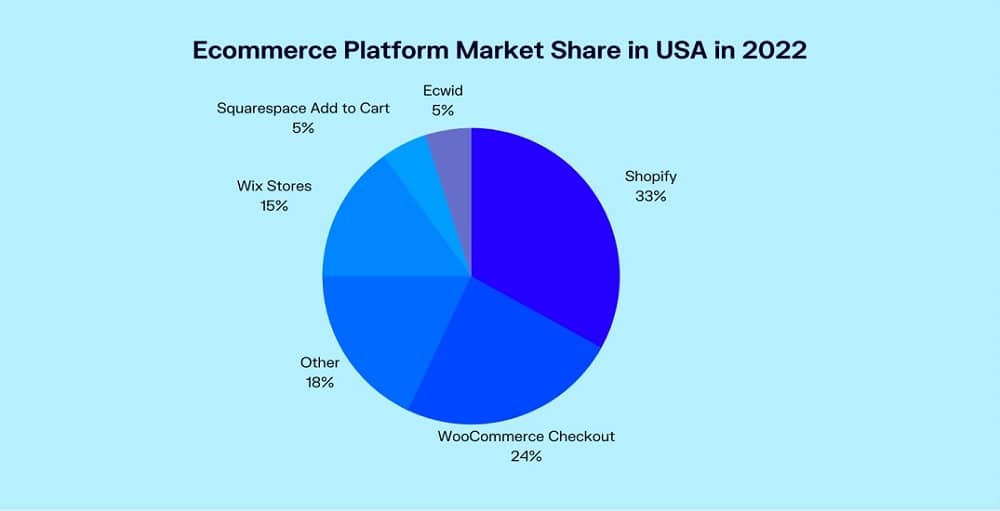
It is one thing to know that Shopify is a household name when e-commerce platforms are discussed. It is also another thing to know how big it is in the market share of its host country. By now, you probably will be imagining how much percentage it takes in the US market. Shopify is one of the most popular e-commerce platforms in the world.
It has 33% of the US e-commerce market share. Its major contender with Shopify in the US e-commerce market is WooCommerce Checkout, with a 24% share. Wix Store follows these two giants with a market share of 15%. Hence, Shopify remains by far the largest e-commerce platform in the US to date.
[Source: Oberlo]
Difference Between Shopify And Wix Revenue?

In the e-commerce market space of the United States, Wix is a big name that competes with Shopify on an international level. As a matter of fact, it has recorded massive successes over the years too.Thus it is not a game of win-win for Shopify.
Although Shopify covers the largest percentage of US market space, Wix makes bigger waves in many angles, too, in Isreal. It is, therefore, will interest you to know the differences between their revenues. In the year 2019, Wix made $761 million as revenue.
During the lockdown in 2020, it made $984 million. Wix had $1.270 billion in 2021 after lockdown. On the other hand, Shopify made $2.92 billion in 2020. As of the middle of this year, Shopify had made $1.29 billion. This is already more than Wix’s whole year revenue of 2021.
[Source: Macrotrend]
Numbers Of Themes Available On Shopify
The themes of e-commerce domains or shops play no small roles in enticing prospective buyers. It is as important as the coloration and design of a website. These themes give the beautiful look and better present the products displayed in the store. Shopify's team of designers has put several elements together to give a quite number of themes.
Thus, there are more than 93 different themes available for business owners to choose from. Among these themes, there are free ones. However, a pretty high number of them are paid for. In addition, business owners are to choose what theme fits best the type of product they sell.
Fortunately, you can filter these themes based on paid or free themes and types of products, as well as the catalog.
[Source: Shopify]
How Many Languages Are Available On Shopify?
There are different languages spoken in different parts of the world. Irrespective of Languages, business is done in every part of the world. As such, the probable language barrier could hinder the use of some e-facilities by certain people. This will limit the pool of buyers to a marketer or business owners.
To rule out this barrier posed by language, Shopify has a feature that supports several language options for business owners. Shopify allows you to sell in up to 20 languages in one store except on the Shopify lite App.
Thus, the multilingual features increase the array of people you can sell to. Fortunately, the major Languages spoken across the world are available on Shopify. This feature explains the wide acceptability of Shopify across many regions of the world.
[Source: Shopify]
What Number Of Apps Is There At Shopify?
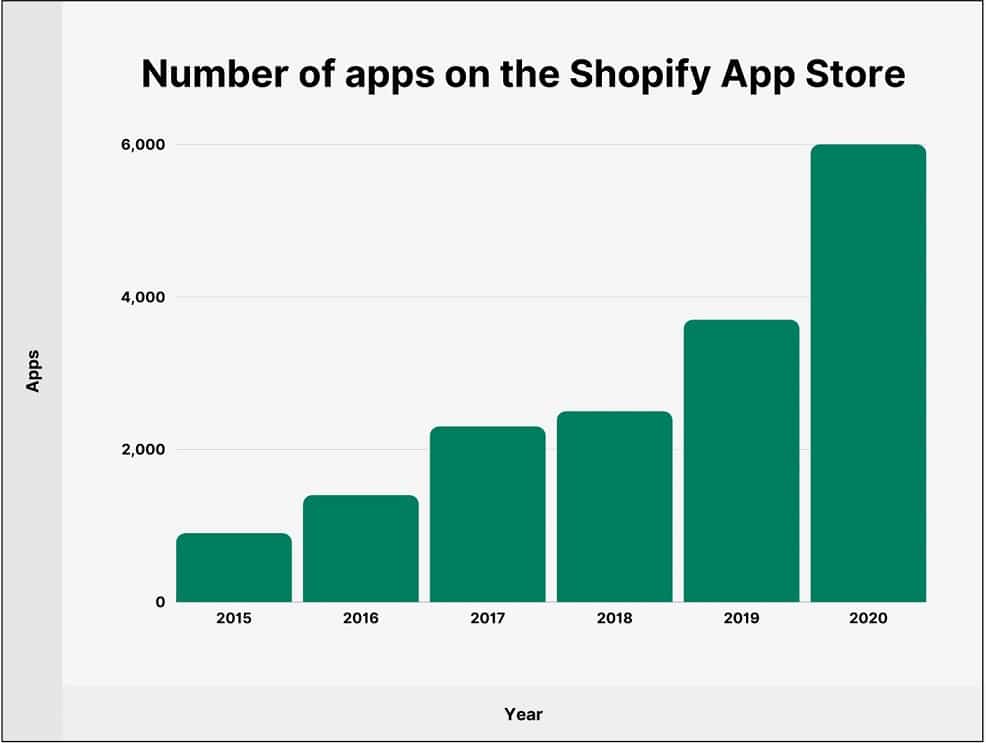
Shopify has many developers who are professionals in app development. Hence, to control the app pool on Shopify stores, the standards are heightened. Owing to this, the chances of a developer's app being launched on the Shopify store is half of the battle. Despite this, Shopify stores have niche specialised apps for merchants.
These apps currently number up to 3200 on the Shopify Store. Merchants, therefore, have various apps that are use-specific and feature-specific. As such, Shopify has an official guide on their website to put merchants through what app fits their needs. So it is advised that you go through the guide before downloading apps on Shopify stores.
[Source: Shopify]
How Long Does It Take to Create A Shopify Store?
While considering having an e-commerce store, people think of many factors. Some of the factors considered are the time it takes to set up the store and how easy the navigation is. As for Shopify, you will like to know how long you will have to spend to get your store created and ready for sale.
Data collected showed that, on average, a store can be set up on Shopify in 25 minutes. This time does not include the time taken to do the planning process. It takes an average of half an hour to create a store on Shopify.
At most, you will spend an hour. However, this is dependent on how familiar you are with the planning process because that takes time. Sometimes days and even weeks.
[Source: Coupler]
How Many Websites Or Domains Can You Have On Shopify Store?
One of the frequently asked questions about Shopify is the number of websites a merchant can have per store. Merchants would like to know how large or spacious a store on Shopify is to contain their multiple business domains. While Shopify allows you to add up to 10 websites or domains to your store, it has a condition.
Irrespective of the type of Shopify store you have, your root domain on Shopify can only be pointed to only one of your Shopify stores. This does not mean you can not create several subdomains to this root domain.
For instance, having your store operated in different countries can warrant creating international domains for each country. This can help bring your market close to the grassroots in the locality of such a country.
[Source: HelpCenter]
What Region Generates Most Shopify’s Revenue?
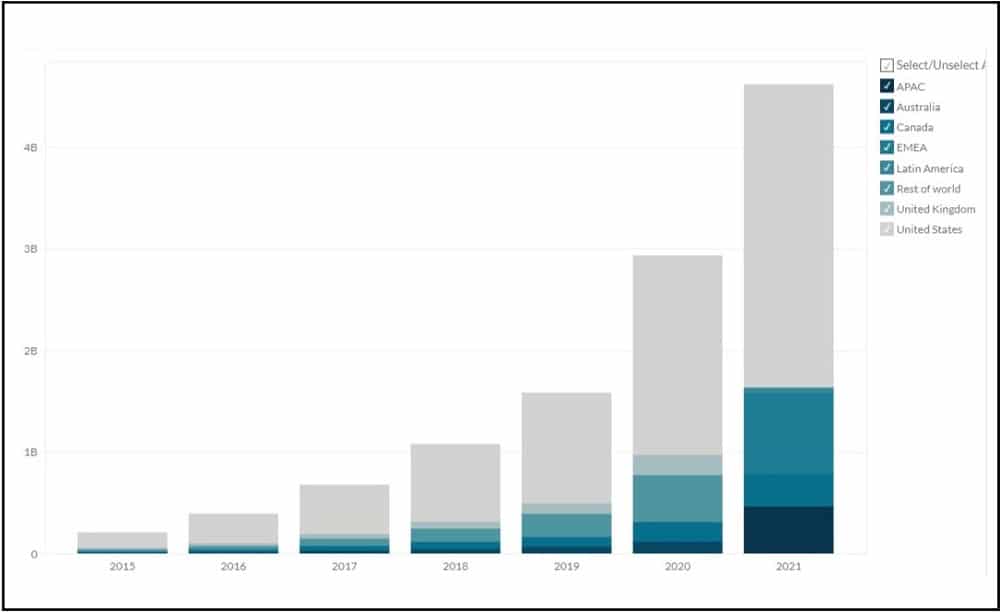
The total revenue of Shopify is generated from different regions and countries of the World. Although the internet presents a level ground for e-commerce users and even the platforms, some regions are more likely to use it better. This is a product of awareness and social intelligence of the people living in each region on global parameters. Shopify, therefore, has a varying amount of revenue from different regions.
On a general scale, 73.3 % of Shopify's revenue is generated from the US, Canada, and Mexico. Thus only 26.7% of the revenue comes from other parts of the world. On a continental scale, North America accounts for $2.15 billion of the total revenue. Thus, it is the region where the bulk of Shopify revenue is generated.
[Source: Demandsage]
What Is Shopify Conversion Rate?
The conversion rate of e-commerce is an integral parameter for measuring the success of the platform. This is derived from the total number of visitors to stores on the platform divided by the total number of purchases made successfully on the platform. Thus, it is a reflection of how much of the leads and traffics generated later became buyers or merchants in the stores.
Analysts have a consensus on 3% being the standard benchmark to declare an e-store a successful one. This means that once 3% of the visitors are convincingly converted to buyers, the online store is a successful one. Shopify stores have an estimated general conversion rate of 1.4%.
This is a reflection of the low rate of success recorded by online businesses. However, when the top 10% of Shopify's successful stores are considered, the conversion rate is 4.7%, with the highest being 8%.
[Source: Style Factory]
How Much Is Shopify Stock Sold?
Multinational corporations, which are publicly traded, sell shares to different individuals and institutions. By so doing, the shareholders bear risks and share profit with the company and its founders. This share is valued on the total percentage of the stock traded by the company.
Shopify had its initial public offering in May 2015. Then, it traded its stocks under the name ‘SHOP’. The sales were done on New York and Toronto stock exchanges. This sale lasted for just 7 days.
Currently, Shopify shares are worth $33.29 per share. Although shares at Shopify had sold at $1,762 per share in 2021, unfortunately, it experienced a sharp fall in 2022. Shopify’s current worth of shares represents a huge decrease of 77.36%.
[Sources: Finance Yahoo, Shopify]
Who Are The Biggest Shopify Customers With Their Respect Market Cap?

On Shopify e-commerce platforms, there are several businesses owner hosting their business and even using the Shopify method of payment. Among these businesses, there are some of them have the highest number of patronages on Shopify.
Thus, they are considered the biggest customers on the Shopify platform. There are 15 major big customers on the list. They rank on the basis of their market value. None of these customers has lesser than a $1 billion market value.
For the purpose of this write-up, we will consider the top 5 biggest customers. Tesla Inc. is first on the list with a market value of $644 billion. Followed by LVMH Moet Hennessy and Nestle with market values of $331 billion and $314 billion, respectively. The fourth and fifth biggest customers are Pepsico Inc. and Anheuser-Busch InBev Sa Nv, with respective market values of $192.6 billion and $106.2 billion.
[Sources: Insider, Finance Yahoo]
Does Shopify Have a Payment Gateway, And How Much Are The Transaction Fees?
It is a culture for big e-commerce platform to develop their own payment methods and gateway. This makes it easy for their customers to pay for goods and services without having to pay extra charges for payments. Shopify has its payment gateway. It, therefore, charges no additional charge except the card fee.
However, it allows users to use other gateways that will obviously charge their own service fee. If you use a third-party payment gateway while u don’t have Shopify payment, you will be charged depending on your Shopify plan.
On the basic plan, you will be charged 2%. Shopify and Advanced Shopify plans have 1% and 2% charges, respectively.
[Source: Eastside]
Conclusion
Shopify has made arguably giant waves in the e-commerce market. The facts and statistical values given up here are enough to prove that. As technology improves, it is projected that Shopify will grow bigger and more efficient.
On the other side of the coin, it is expected that competition will increase as no business has a monopoly on technology or the internet space. However, the US territory might be difficult to claim by other e-commerce platforms at the expense of Shopify.
That being said, only time will tell if Shopify will be able to withstand the growing stiff competition, especially from the Chinese and UK e-commerce platforms.






